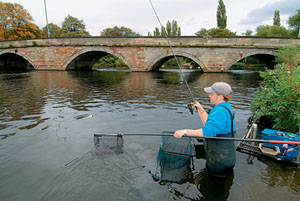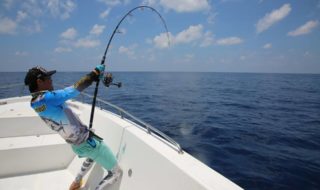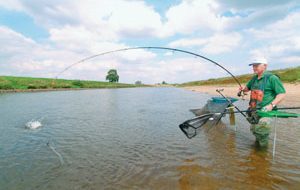Word has reached us that the River Tame and the nearby Anker are fishing better than ever, so we joined local angler Scott Geens to find out more.
| There is a bit of a walk to your peg but there’s great float fishing at the end of it. |
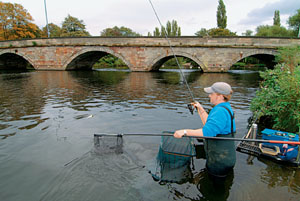 |
DIRTY and polluted might be the first two words that would come to mind at the mention of the River Tame at Tamworth, but you would be very wrong in your assumptions, writes Scott Geens.
Try instead, clean and fish-filled and you might be a lot closer to the present-day truth. In fact, recently the venue has been fishing really well for roach and chub. So much so that even the midweek matches on the Tame and the nearby Anker are attracting fields of nearly 30 anglers. It’s no surprise, because the matches are producing loads of double-figure bags of silver fish and winning weights of 25lb plus.
And, of course, pleasure anglers can have much better sport than that. This is brilliant fishing in the depths of winter by anyone’s standards.
The Tame actually flows past the back of my house, but I have never fished it there, as it is shallow, weedy and not very wide.
However, good catches being taken where I am today, at Tamworth, prompted me to investigate further and it immediately became apparent that the stretch is full of fish.
This session is not all about the venue, though, as I want to pass on some general advice about fishing swift venues like this with both the stick float and waggler. So if you are not interested in working hard and standing up to fish, then, as the newsreaders say: “Look away now!”
Weir swim
My swim today is below a bridge and above a weir. To my mind it’s an ideal peg with a lot of options and one that holds loads of fish. The flow is varied and the first decision has to be where exactly to fish.
I’m going to feed and fish two main areas. I’ll have an inside line that I’ll fish with a stick float about two rod lengths out and a mid-river line where I’ll use the waggler about 25 metres out.
I’m not expecting anything really big here and the target species will be roach, perch, skimmers, dace and small chub.
Therefore, a sensibly balanced set-up is required. I will use two Shimano Nexave 390 match rods, which have a mellow action and are capable of handling hooklengths down to 0.08mm diameter if necessary.
Main line is Shimano Exage multipurpose in 0.16mm diameter. If I need to make it float then I can add some proprietary line-floatant spray. Hooklengths are made up from Shimano Antares line in 0.10mm or 0.12mm diameters.
My preference is for a hooklength of around 18 inches on rivers. This allows a natural fall to the bait, but I can avoid placing too many shot on the hooklength, which would be necessary if it were longer. Placing shots on the hooklength could result in a weak spot and we all know what might happen then! One or two small, soft-lead shot are usually enough.
Waggler set-up
| Scott caught all sorts, including quality roach, dace, perch and skimmers. |
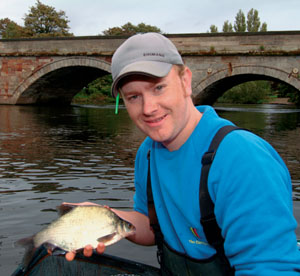 |
Let’s have a look at the waggler rig first of all. When you pick a waggler, you need to use one that you can comfortably cast beyond where you intend to fish.
This allows you to cope with any change in the wind strength or direction. If the wind turns stronger and into your face, you need a float that’s heavy enough to punch it through the wind to where you are feeding. This is more important than delicate bite registration with a light float – the pace of the river is what pulls the float under much of the time and fish in rivers have to take bait aggressively anyway. If they don’t, it gets past them to the next fish.
That said, I always use a quick-change float adaptor so that I can readily switch floats should the need arise, or if the float breaks or is lost.
I have opted for a standard straight peacock waggler with an orange tip. A straight peacock is one that is the same diameter all the way through, whereas an insert waggler has a thinner, more sensitive piece of peacock inserted at the tip.
However, light conditions can change and you need to be armed with various floats in various tip colours, with white, black and yellow the most useful alternative colours – all the more reason for using a float adaptor.
On the drop
The float is locked on the line with AAA shot. Down the line, I spread No8 and No10 shot equally, to give the bait a natural fall with the intention of tempting fish at all depths.
I’d suggest that you use one shot for every foot of depth. If the water is more than eight feet deep then I would be inclined to bulk several shots at mid-depth and spread them out below that. What you are doing in that instance is effectively lengthening the float. By this I mean that shot down the line are like little transmitter relay stations.
If a shot fails to settle then you have a bite on the drop and if a fish lifts a shot as it takes the bait you will get a lift bite. Of course the float will go under more often than not when a fish makes off with the bait, but each shot down the line helps to transmit any movement back to the float.
I don’t dot down a waggler on a river like you would on a stillwater. You need to have about 2cm of the tip visible so that, if the bait brushes against anything on the bottom as it moves down the river, it won’t pull the float under too easily.
Stick float
The stick-float rig is for fishing much nearer to me. There is a decent depth close in on this peg with some slacker water. Fish such as big perch will tend to hug this kind of territory, as well as bream and bonus chub.
I have opted for a Drennan Alloy Stick taking four No4 shot. Sorry if I’m teaching you to suck eggs, but that does not mean that you just put four No4 shot on and leave it at that.
It is merely a size guideline. Shotting of stick floats is always best done with smaller shot. For example, I will use nine No10s in a bulked group, set just below mid-depth today and then spread individual No10s down the line below that.
If you are used to pole fishing, then the shotting-pattern system with stick floats is largely similar, that is, use smaller shot to achieve finer bait presentation.
My hook choice on both set-ups is a Colmic N957 in size 20 or 18. One additional tip when using a stick float is to utilise three rubbers on the float, just in case one breaks.
Casters and hemp
So how am I going to combine these rigs today and bring together a nice bag of fish?
Well, let’s start fishing and I will try and talk it through and explain what I do, when I do it, and what the results are.
In terms of bait, I have two pints of hempseed, two pints of casters and two pints of largely bronze maggots with a few reds to act as change bait.
Bronze tends to be best for the roach and chub, but reds are good for perch and can pick off the bigger dace and skimmers.
I’m hoping to feed all six pints of bait today. An expensive day’s fishing? Some might argue that, but with a nice bag of fish as a reward, then I consider it money well spent.
I always err towards feeding hempseed and casters rather than maggots, although maggots are my main hook baits.
Ultimately, experience has shown that these baits, fed in combination, generally attract, and hold, better-quality fish compared to feeding solely with maggots.
Before I commit any bait to either line I will have a few runs through each swim with no bait on the hook, just to get used to the depth and where the potential snags might be.
This is important, as I need to be sure that when the float goes under it’s an indication from a fish and not the bottom. It’s easy to do. Just use a plummet to gauge the depth and then keep moving the float until the float drags under. Then move it back up, an inch at a time, until it runs through fine.
Once this is done I’ll then have a couple of chucks with a double bait on the hook as, with mine being the only bit of food around, I might just tempt a bonus fish.
Building the swims
Normally, two to three pouches of hemp and casters should be fired into each area as an opening gambit.
I will start on the waggler, and while I’m fishing this I will build up the inside line with a dozen grains of hemp and some casters every couple of minutes.
This will give the fish confidence for later, but at the same time you have to be careful not to overfeed them too quickly.
As I’m fishing the waggler, I’ll feed hemp and casters on the stick-float line too. I’ll feed directly in front of me rather than upstream. This prevents the fish coming too far up the peg to take the free food. You don’t want fish to be above you, because you can’t present bait to them effectively if they are. One skill you should try to learn is feeding with a catapult while still holding the rod, although if your keepnet has a strong locking-system device you can simply balance the rod on it while you feed.
It could be argued that feeding first is better, but at least the float running through the swim gives you something to aim at. On balance, I think that when feeding maggots it is more of an advantage to feed before you cast, but not with hemp and casters as they sink quicker.
Presenting your bait
When you cast a waggler rig out, aim about a metre downstream of you. You are looking to land the float and feather the line off the reel in the final moments, so that the line below the float lands out in front of it without tangling and in a straight line.
This keeps you in touch with the bait as it sinks and means that you get indications if you get a bite on the drop. If it all lands in a heap, you won’t get these indications.
By casting downstream, your line between the float and your rod will always be upstream of the float and therefore more manageable.
You can then have some measure of control over the float and your strike will be more direct. It is necessary to get into a nice rhythm of casting, feeding, and catching.
Hook baits
On both rigs I use various hook baits, but even though I am feeding hemp and casters, I would tend to err towards using maggots on the hook. That’s mainly because the fish tend to hold onto them for longer. This is especially important when fishing further out on the waggler line and you thus hit more bites.
On the stick-float rig, casters can be particularly effective as the strike is more direct and you will miss fewer bites as a result.
Double red and bronze maggots can be very effective too and I try all permutations as a session unfolds to find out what the fish favour on the day.
With consistent feeding, it has taken under 10 minutes to get the fish queueing up to take the bait on the waggler line.
I’m going to plunder this for at least an hour, catching mainly roach, with some dace and small chublets.
However, when I make the switch to the stick float, I will continue to feed the waggler line.
Earlier I mentioned that those who don’t like to work hard at their fishing should not bother to read this. Well now you can see just how active this two-pronged approach needs to be. It’s non-stop really and you certainly know you have been fishing at the end of a day!
Stick tips
Flicking the stick float out underarm and allowing the rig to land in a straight line on the water is integral to success.
Keep the line behind the float and feed it off the spool in a measured and controlled way. It’s worth trying to fish it at the pace of the current, as well as holding back on the float to slow the bait down. The latter is especially useful when it’s cold and the fish are less inclined to chase bait, whereas in summer it’s often best to ‘run it at ‘em’.
On both the stick and the waggler, it is also often necessary to vary the depth. Sometimes changing it just a little works wonders, but at other times a change of a foot, either overdepth or off the bottom, can make a huge difference in the catch rate. As a rule of thumb I’ll try fishing off the bottom more readily in summer, when the fish are more active.
However, don’t forget that, in a river, fish need to keep expending energy, so they are active even in winter and have to feed. As in all types of fishing, the golden rule is: if it’s not working, change something.
Bag of silver
Today has seen me do well on a river that’s in almost perfect trim. When anglers who only fish stillwaters hear this phrase, they don’t know what I mean, so I will explain.
When rivers are very coloured, straight after a flood, it’s difficult for the fish to see the bait, especially one that’s moving, so it’s hard to catch on the float.
When it’s extremely clear, small silver fish are in great danger from sight-feeding predators and become very wary and, thus, harder to catch. These predators include pike, zander, perch and cormorants.
However, if a river is carrying some colour, but not too much, fish can see your bait but the predators can’t see them and they feed readily. It’s hard to make a rule of thumb on this as all rivers are different, but quite often many rivers come just right around three or four days after a flood.
Today I’ve plundered two or three nice perch to just under 1lb from the stick-float line, as well as a couple of skimmers. Those fish have come in the last hour, which is typical.
The bulk of the fish have come on the waggler and it is has been a joy to fish it with only a light breeze to cause any problems.
Wind does have a big bearing on float fishing on rivers. If it is windy you want it to be blowing upstream. An upstream wind will hold the line above the float back behind it, and actually help slow the bait down, aiding excellent presentation.
A downstream wind, however, can be a nightmare as it pushes the line above the float in front of it. When this happens, the rig is pushed through faster than the flow of the river. The result is that your bait is going through too fast and looks unnatural and fish won’t take it. The only answer in these conditions is to use a line sinkant above the float on the waggler line, or to back shot with No8 shot above the stick float.
Once you have practised this form of fishing on a river venue where there are plenty of fish to be had, then I am convinced you won’t want to go near a commercial carp fishery every again! Okay, maybe that’s an exaggeration, but it will hopefully broaden your horizons and add more variety to your fishing.
The great news is that the Tame and the nearby Anker are in great form and will fish all through the winter. I know of several more Midlands rivers that have fished brilliantly this season, proving that the cormorants have not had all the fish.
Long live running-line fishing and long may the revival of the Tame continue!
Top Tip
In winter Scott likes to start on the waggler line with the bait just off bottom. He gets a rough idea of the depth using a plummet and then adds depth until the float drags under. He then shallows up an inch at a time until the float runs through. Once he’s got the depth right, he moves one of the small dropper shot up to the bulk.
Top Tip
If he’s feeding maggots on the waggler line, he likes to feed before he casts. However, he has found that feeding casters and hemp brings in, and holds, a better stamp of fish. When he is doing this, he casts in first, rests his rod on his keepnet, then feeds.
Bait Menu
Hemp and caster feed seems to hold a better stamp of fish than maggots.
Single maggot is the standard hook bait on the waggler. Be careful not to ‘burst’ the bait.
Double maggot is a good change hook bait, with red and bronze the standard colours.
Caster hook bait is used on the stick-float line to pick of quality roach, skimmers and perch.
Top Tip
Scott likes to fish with an 18in hooklength on rivers. He’ll place two dropper shot on this hooklength, but says it’s very important that you use soft shot, such as the Preston Slip Shot.
Tame Tackle
Scott’s team is sponsored by Shimano and he uses a Nexave 390 match rod.
Line-wise, it’s 0.16mm Exage for the reel and 0.10mm or 0.12mm Silk Shock for the hooklength.
Don’t dot the tip of the straight peacock waggler right down. Scott likes to leave about 2cm showing.
His hook choice for both waggler and stick float is the Colmic N597 in sizes 20 or 18.
On the waggler, No8 shot were spread down the rig; firstly in groups of two and then singly.
On the stick float he used a bulk of No10 shot just below mid-depth and then droppers below.
Venue Fact File
River Tame, near Tamworth, Staffs
Contact: Dosthill AC controls the Tame and the Anker at Tamworth, where they meet. Call Horace Jones on 01827 316267 for more details
Tickets: Day tickets £2.50 on the bank. A club book is £13 for the season
Nearby tackle shop: Allen’s of Kingsbury, Premier Angling Centre, Coventry Road, Kingsbury, Tamworth, Staffordshire, B78 2LW. Tel: 01827 872451
Restrictions: No fishing on the pegs just above the weir at weekends. It’s members only at that time
Matches: Call John Stevens 07971 854104 for more details
How to get there: Scott fished below the Fazeley Road bridge. Access is from off the A453 Riverdrive south of the town centre. You have to park and walk about 300 metres to the bridge, as there is no vehicular access. So clear out what you don’t need and bring a trolley – preferably a barrow version!


